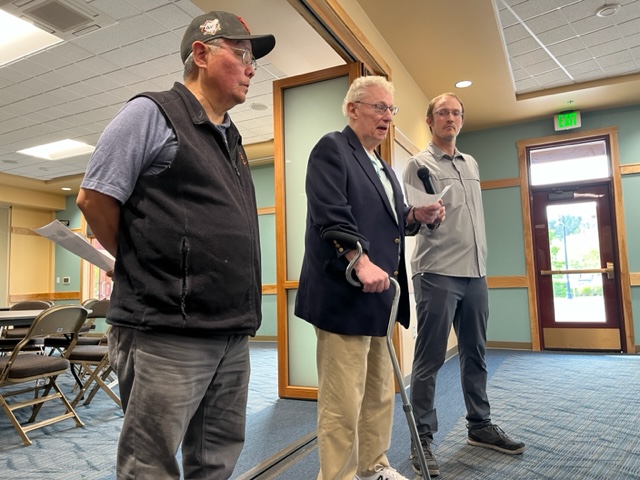
Sitka’s municipal and tribal governments are celebrating a quarter-century of official cooperation. Representatives of both governments – past and present – met last Tuesday (7-11-23) to reflect on a Memorandum of Understanding that was the first of its kind in Alaska, and – despite some bumps along the way – has stood the test of time.
The Memorandum of Understanding established cooperative government-to-government relations “for the benefit of the Sitka community as a whole” when it was signed on July 11, 1998. City officials say it was the first of its kind in the state.
Current and former city staff and tribal council members, along with many community members, gathered in Harrigan Centennial Hall on July 11 to recall how the memorandum was first developed, and what it means to the community now.
Gary Paxton, who was city administrator when the memorandum was signed, said that the document demonstrated both governments’ commitment to collaboration.
“The work with the EPC, the mill closure, then eventually taking over Gavan subdivision and moving the city shops – all those things pale in comparison to the MOU,” Paxton said.
Stan Filler, who was mayor at the time of the signing, said that the document was one of the best projects he was involved in as mayor.
“It brought us all together again,” Filler said. “And that’s the way it should be.”
Tribal Council member Frederick Olsen, Jr. noted that a strong working relationship between city and tribe shouldn’t be taken for granted.
“This is rare,” Olsen said. “You don’t have to have this kind of relationship between the city and the tribe. Often there is a relationship, and it’s bad, you know. They’re adversaries.”
Sitka Tribe of Alaska transportation manager Gerry Hope said that the success of the memorandum is a testament to the hard work of the original writers, and to those who have continued to make it work.
“There are other tribal councils that have inquired and said, I heard you guys have an MOU, can you send me that, and for whatever reason, that doesn’t get off the ground and get traction in those tribal communities or those other municipalities,” Hope said. “So it takes a perfect, perfect set of characters on both the tribe and the City Assembly to craft that, but also to make it work.”
The City and Tribe have collaborated on a number of projects, including funding the paving of Indian River Road, establishing a child advocacy center, and creating a domestic violence prevention team. The governments also hold semi-annual meetings to discuss issues of mutual interest.

Tribal Council chairman Lawrence “Woody” Widmark, who signed the memorandum 25 years ago, noted that although the relationship has had bumps and bruises, the memorandum has marked a major improvement.
“Now, we’re partners with the city, and I never would have dreamed of that,” Widmark said.
Though the relationship may be tight-knit, there’s always a little tension – at least about who’s buying lunch. As City Administrator John Leach said,
“Chair Widmark, I think it’s your turn to buy our lunches – it’s been two in a row, right?”
The ceremony was followed by cake, and a citation was presented by Mayor Eisenbeisz at the following Assembly meeting.
Editor’s note: For purposes of disclosure, besides serving on the Sitka Tribal Council, Fred Olsen is an employee of KCAW.






























